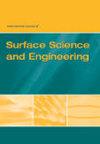Ultrasonically nanostructured electric-spark deposited Ti surface layer on Ti6Al4V alloy: enhanced hardness and corrosion resistance
IF 1.2
4区 工程技术
Q4 ENGINEERING, MECHANICAL
International Journal of Surface Science and Engineering
Pub Date : 2020-03-10
DOI:10.1504/ijsurfse.2020.10027541
引用次数: 8
Abstract
A complex approach for the production of corrosion resistant nanostructured surface layer on the Ti6Al4V alloy is reported in this article. Surface modification was conducted using sequential application of electric discharge surface alloying (EDSA) with α-titanium and ultrasonic impact treatment (UIT) induced the nanostructuring of the EDSA-formed Ti-layer. X-ray diffraction and TEM analysis show that the applied modifications form the outmost surface layer of ~20 μm thick comprised the nanoscale grain structure with a grain size of 10-30 nm. Additionally, the UIT-induced mechanochemical oxidation of the modified surface was observed by SEM with energy dispersive X-ray microanalysis. The produced nanostructured α-titanium surface layer shows enhanced microhardness and better corrosion behaviour in saline solution than those of the original and UIT-processed Ti6Al4V alloys. Thus, the complex treatment applied can be recommended for the surface finishing of the products made of multi-phase titanium alloys, such as biomedical implants.Ti6Al4V合金表面超声纳米电火花沉积Ti表面层:提高硬度和耐腐蚀性
本文报道了一种在Ti6Al4V合金上制备耐腐蚀纳米结构表面层的复杂方法。采用α-钛的放电表面合金化(EDSA)和超声冲击处理(UIT)的顺序应用进行表面改性,诱导EDSA形成的Ti层的纳米结构。X射线衍射和TEM分析表明,所施加的改性形成了约20μm厚的最外表面层,包括晶粒尺寸为10-30nm的纳米级晶粒结构。此外,通过SEM和能量色散X射线微观分析观察了UIT诱导的改性表面的机械化学氧化。与原始和UIT处理的Ti6Al4V合金相比,所制备的纳米结构α-钛表面层在盐水溶液中表现出更高的显微硬度和更好的腐蚀行为。因此,所应用的复杂处理可以推荐用于由多相钛合金制成的产品的表面精加工,例如生物医学植入物。
本文章由计算机程序翻译,如有差异,请以英文原文为准。
求助全文
约1分钟内获得全文
求助全文
来源期刊
CiteScore
1.60
自引率
25.00%
发文量
21
审稿时长
>12 weeks
期刊介绍:
IJSurfSE publishes refereed quality papers in the broad field of surface science and engineering including tribology, but with a special emphasis on the research and development in friction, wear, coatings and surface modification processes such as surface treatment, cladding, machining, polishing and grinding, across multiple scales from nanoscopic to macroscopic dimensions. High-integrity and high-performance surfaces of components have become a central research area in the professional community whose aim is to develop highly reliable ultra-precision devices.

 求助内容:
求助内容: 应助结果提醒方式:
应助结果提醒方式:


